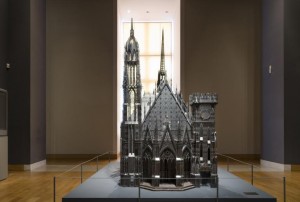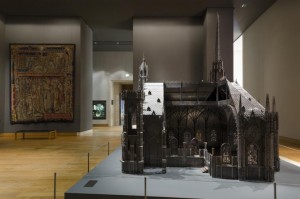ARTIST: Wim Delvoye
WORK NAME: Chapel (Scale Model) 2007
LOCATION FOUND: http://www.wimdelvoye.be (Artist’s Personal Website)
Immediate Response:
Primarily, I chose Wim Delvoye as my artist because a lot of his sculptural works incorporated architectural elements into them. I find his work fascinating because of his use of 3D modeling in his sculpture creating process. When I saw his work Chapel, I was at first amazed by the sheer precision of every surface and facet. What I particularly liked about this work was his use of a cutaway section. When I was younger, I loved books that showed, not only the exteriors of buildings, but also the interiors and how the exterior of the building was reflected in the interior and how the style carried over. Seeing this work, my childhood fascination again showed itself and made me really like this work of art.
Objective Description:
The work itself sits on a flat, gray base, which becomes part of the floor of the chapel when viewed through the cutaway side. The work is incredibly intricate and looks to be a scale architectural recreation of an existing gothic structure. On the entrance side of this structure, there are three main entranceways all capped by a pointed gothic arch. On either side of the archways are two towers. The tower on the left is much higher than the right and is capped by a pointed peak. The other tower is lower and doesn’t even come all the way to the height of the roof of the chapel. This tower, in addition to being much shorter, also is capped with a flat top with medieval-looking battlements on top. The church itself is shaped in your typical cruciform manner with another peaked steeple over the crossing. The gothic windows all appear to actually be made of glass while the rest of the structure seems to be made of metal sheeting cut very thin, probably with a laser cutter or an equivalent machine. The cutaway section (on the right side of entranceway) shows a highly ornate interior in terms of architectural elements, but lacks any sort of seating. Also, the interior seems to be much smaller than the exterior, almost as if the scale had suddenly shifted on the inside. The interior seems to be much more compacted than the exterior would suggest.
Technical Decisions:
I find this work to be incredibly interesting, especially in terms of the material choices used in its construction. The materials, as described by the blurb given by the artist, were laser-cut corten steel and stained glass. I think that the artist chose to use materials that closely resembled what the actual structure was made out of. However, since stone would probably be too difficult to manipulate and work into a smaller project, laser-cut metal would work incredibly well, especially if sanded down to look less metallic, which is what it looks like the artist has done. Interesting, though, is that some parts of it look to still be metallic in color, maybe because these elements would be made of metal on an actual gothic chapel. The stained glass is very interesting because it shows that the artist is really trying to be as close in detail as possible to the real thing. He could have simply left the windows without glass, but he chose to make the scale model realistic, instead.
The Work in the World:
I think that one of the main reasons why this work was created is to show off the technical capabilities of machinery and how modern fabrication methods, such as laser cutting and 3D printing, can be an accurate and fascinating way of producing works of art (and architecture in this case). I also think that Wim Delvoye may have even wanted to contrast the modern materials with the old architectural style. I find it strange, yet intriguing, that Delvoye would choose to recreate a gothic chapel. Perhaps he was trying to preserve history using modern methods and materials.
The Story It Tells:
As previously mentioned, I think that this work is meant to stand as a sort of reminder of the past, yet a view of it through a modern lens. As he explains in an interview, his works, and one of his goals as an artist, is not to worry whether his works are truly “artistic” or not, but rather to show things that are beautiful and visually intriguing. One of the other issues that he discusses is that his art could not possibly be duplicated if given to a renaissance sculptor. I believe that his work is trying to show sort of the opposite, that modern invention and skill has surpassed older styles and methods of production.

